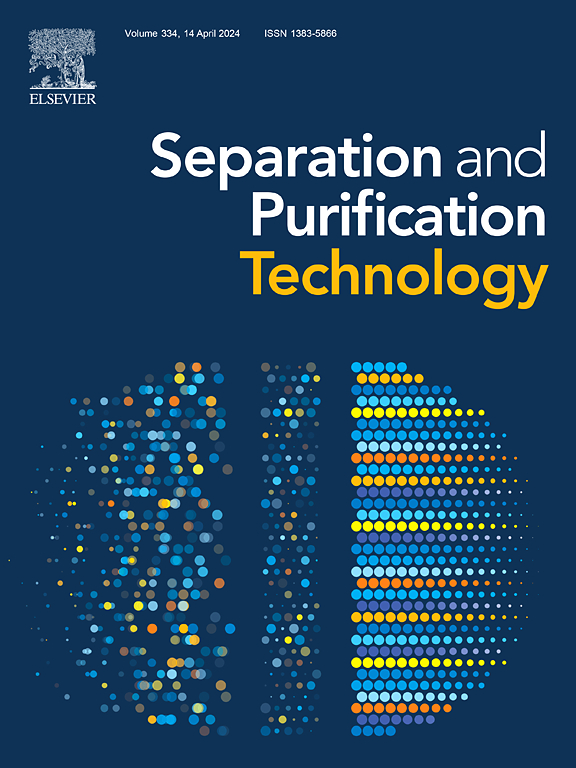水浸环境下单碱推进剂中溶剂在硝化纤维素基体中扩散的分子动力学研究
IF 8.1
1区 工程技术
Q1 ENGINEERING, CHEMICAL
引用次数: 0
摘要
通过分子动力学研究了乙醇-乙醚和乙醇-丙酮混合溶剂在硝化纤维素(NC)水浸除溶剂过程中的扩散机理。这项工作首次探索了NC氮含量和非均相氮分布对溶剂扩散的影响。虽然结果表明乙醇- nc相互作用以氢键为主,但乙醇由于其分子体积小,具有较高的跳跃频率和较低的位阻,因此具有最高的扩散系数。相比之下,乙醚和丙酮主要通过范德华力与NC相互作用。溶剂扩散系数随温度升高、含水量增加、NC氮含量增加或氮分布不均而显著增加,这是由于溶剂-NC氢键减弱所致。温度的升高加剧了溶剂分子的热运动,增大了体系的自由体积,从而增强了溶剂的扩散。水含量的增加推动水、溶剂和NC分子之间形成新的相互作用网络,减弱溶剂-NC相互作用,增强溶剂- h2o相互作用。这些变化使具有更大流动性的水分子携带溶剂分子,促进溶剂分子的扩散。氮含量的增加和氮的非均相分布增强了NC内链的氢键。这些导致链收缩和减少羟基可用于氢键NC与溶剂之间的数量,增强溶剂扩散。当K为298 ,氮含量为11.08 %时,非均相氮分布可使溶剂扩散系数增大46.19 %。本研究为理解单基推进剂的溶剂去除过程提供了理论基础。本文章由计算机程序翻译,如有差异,请以英文原文为准。

Molecular dynamics investigation of solvent diffusion through nitrocellulose matrices in single-base propellants under water leaching environment
A detailed molecular dynamics study was conducted to investigate the diffusion mechanisms of ethanol-ether and ethanol-acetone mixed solvents in nitrocellulose (NC) during water leaching for solvent removal. This work presents the first exploration of the impact of NC nitrogen content and heterogeneous nitrogen distribution on solvent diffusion. Although results show hydrogen bonding predominates in ethanol-NC interactions, ethanol exhibits the highest diffusion coefficient due to its small molecular volume, which enables high jump frequency and low steric hindrance. In contrast, ether and acetone primarily interact with NC via van der Waals forces. Solvent diffusion coefficients significantly increase with elevated temperature, higher water content, increased NC nitrogen content, or heterogeneous nitrogen distribution, resulting from weakened solvent-NC hydrogen bonding. The increase of temperature intensifies solvent molecular thermal motion and increases the free volume of system, thus enhancing solvent diffusion. An increase in water content drives the formation of new interaction networks among water, solvent and NC molecules, weakening solvent-NC interactions whereas strengthening solvent-H2O interactions. These changes enable water molecules with greater mobility to carry solvent molecules, facilitating solvent molecules diffusion. The increase of nitrogen content and heterogeneous nitrogen distribution enhances hydrogen bonding of NC intrachain. These lead to chain contraction and reduces the number of hydroxyl groups available for hydrogen bonding between NC with solvent, enhancing solvent diffusion. At 298 K and 11.08 % nitrogen content, heterogeneous nitrogen distribution can increase solvent diffusion coefficients up to 46.19 %. This work provides a theoretical basis for understanding the solvent removal process in single-base propellants.
求助全文
通过发布文献求助,成功后即可免费获取论文全文。
去求助
来源期刊

Separation and Purification Technology
工程技术-工程:化工
CiteScore
14.00
自引率
12.80%
发文量
2347
审稿时长
43 days
期刊介绍:
Separation and Purification Technology is a premier journal committed to sharing innovative methods for separation and purification in chemical and environmental engineering, encompassing both homogeneous solutions and heterogeneous mixtures. Our scope includes the separation and/or purification of liquids, vapors, and gases, as well as carbon capture and separation techniques. However, it's important to note that methods solely intended for analytical purposes are not within the scope of the journal. Additionally, disciplines such as soil science, polymer science, and metallurgy fall outside the purview of Separation and Purification Technology. Join us in advancing the field of separation and purification methods for sustainable solutions in chemical and environmental engineering.
 求助内容:
求助内容: 应助结果提醒方式:
应助结果提醒方式:


